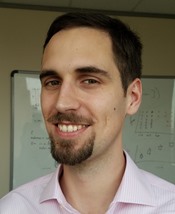Program Information
Image-Based Camera Tracking: Towards Registration of Endoscopic Video to CT
S Ingram1,2*, J Yang1 , B Beadle1, A Rao1,2, R Wendt1,2, R Castillo1,2, L Court1,2, (1) UT MD Anderson Cancer Center, Houston, Texas (2) UT Graduate School of Biomedical Sciences, Houston, Texas
Presentations
SU-C-18A-2 Sunday 1:00PM - 1:55PM Room: 18APurpose: Endoscopic examinations are routinely performed on head and neck and esophageal cancer patients. However, these images are underutilized for radiation therapy because there is currently no way to register them to a CT of the patient. The purpose of this work is to develop a method to track the motion of an endoscope within a structure using images from standard clinical equipment. This method will be incorporated into a broader endoscopy/CT registration framework.
Methods: We developed a software algorithm to track the motion of an endoscope within an arbitrary structure. We computed frame-to-frame rotation and translation of the camera by tracking surface points across the video sequence and utilizing two-camera epipolar geometry. The resulting 3D camera path was used to recover the surrounding structure via triangulation methods. We tested this algorithm on a rigid cylindrical phantom with a pattern spray-painted on the inside. We did not constrain the motion of the endoscope while recording, and we did not constrain our measurements using the known structure of the phantom.
Results: Our software algorithm can successfully track the general motion of the endoscope as it moves through the phantom. However, our preliminary data do not show a high degree of accuracy in the triangulation of 3D point locations. More rigorous data will be presented at the annual meeting.
Conclusion: Image-based camera tracking is a promising method for endoscopy/CT image registration, and it requires only standard clinical equipment. It is one of two major components needed to achieve endoscopy/CT registration, the second of which is tying the camera path to absolute patient geometry. In addition to this second component, future work will focus on validating our camera tracking algorithm in the presence of clinical imaging features such as patient motion, erratic camera motion, and dynamic scene illumination.
Contact Email:


